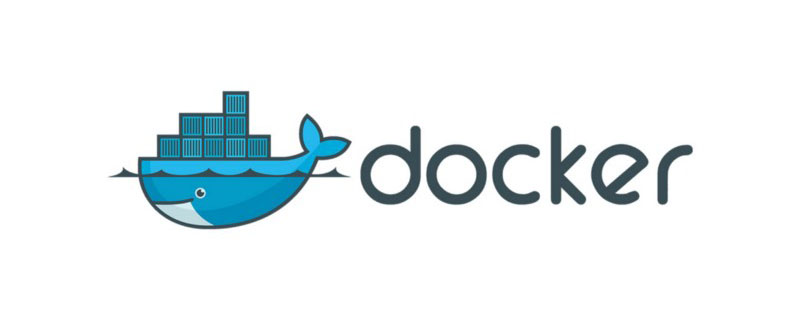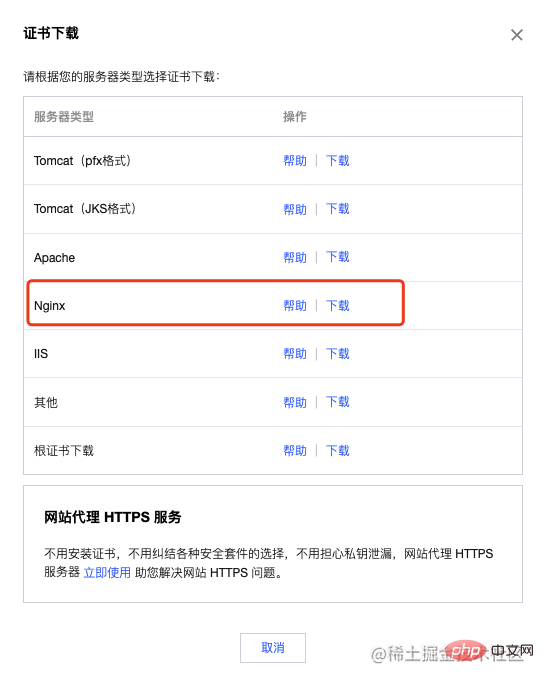 Operation and Maintenance
Operation and Maintenance
 Docker
Docker
 Let you understand how to install Nginx and build a static server based on Docker
Let you understand how to install Nginx and build a static server based on Docker
Let you understand how to install Nginx and build a static server based on Docker
This article brings you relevant knowledge about how to install Nginx to build a static server based on docker. It is very common to use nginx as a static server. The following is mainly Let’s talk about installing and managing our nginx through docker, and configuring the ssl certificate to enable HTTPS access. I hope it will be helpful to everyone.

Everyone needs a server. The static server configuration requirements are not very high. We recommend 1 core 2G and above.
1. Install Docker
##linuxThe server uses curl to download the quick installation shellscript
curl -fsSL get.docker.com -o get-docker.sh
ls command. If it already exists, use the sh command to execute this script
sh get-docker.sh
root user, you need to use sudo su to obtain super administrator privileges .
Docker Server
systemctl start docker
docker version command to see Client and Server is started successfully.
docker run -d -p 80:80 --name nginx \
-v /home/nginx/html:/usr/share/nginx/html \
-v /home/nginx/logs:/var/log/nginx \
nginx:latest
Copy after login
2. Copy the configuration file in the container to the localdocker run -d -p 80:80 --name nginx \ -v /home/nginx/html:/usr/share/nginx/html \ -v /home/nginx/logs:/var/log/nginx \ nginx:latest
docker container cp nginx:/etc/nginx /home/nginx/
cd /home/nginx
mv nginx conf
Copy after login
3. Delete the previous containerdocker container cp nginx:/etc/nginx /home/nginx/ cd /home/nginx mv nginx conf
docker stop nginx
docker rm nginx
Copy after login
4. Run the new container according to the local configuration filedocker stop nginx docker rm nginx
docker run -d -p 80:80 -p 443:443 --name nginx \
-v /home/nginx/conf:/etc/nginx \
-v /home/nginx/logs:/var/log/nginx \
-v /home/nginx/html:/usr/share/nginx/html \
nginx:latest
Copy after login
If no configuration is requireddocker run -d -p 80:80 -p 443:443 --name nginx \ -v /home/nginx/conf:/etc/nginx \ -v /home/nginx/logs:/var/log/nginx \ -v /home/nginx/html:/usr/share/nginx/html \ nginx:latest
sslCertificate enabledhttpsAccess, you can use this nginx as an ordinary static server at this time.
/home/nginx:
conf: nginx configuration file, specific For configuration, please see the official website
html: Put static resources, such as html, css, js, etc.
logs: Logs folder, the access logs can be viewed in it
nginx throughdocker restart nginx.
Tencent CloudSSL Certificate, after submitting the application information, a txt type of domain name resolution will be configured, and then wait for approval.
nginx server type certificate.

cert## in conf/conf.d #Certificate folder<div class="code" style="position:relative; padding:0px; margin:0px;"><pre class="brush:php;toolbar:false">cd /home/nginx/conf/conf.d
mkdir cert</pre><div class="contentsignin">Copy after login</div></div>Upload the certificate you just downloaded to this folder
3. Modify nginx configuration to enable HTTPS access
vi /home/nginx/ conf/conf.d/default.confWrite the following content
server {
#SSL 访问端口号为 443
listen 443 ssl;
#填写绑定证书的域名
server_name 0101.ml;
#证书文件名称
ssl_certificate /etc/nginx/conf.d/cert/0101.ml_bundle.pem;
#私钥文件名称
ssl_certificate_key /etc/nginx/conf.d/cert/0101.ml.key;
ssl_session_timeout 5m;
#请按照以下协议配置
ssl_protocols TLSv1 TLSv1.1 TLSv1.2;
#请按照以下套件配置,配置加密套件,写法遵循 openssl 标准。
ssl_ciphers ECDHE-RSA-AES128-GCM-SHA256:HIGH:!aNULL:!MD5:!RC4:!DHE;
ssl_prefer_server_ciphers on;
location / {
#网站主页路径。此路径仅供参考,具体请您按照实际目录操作。
root /usr/share/nginx/html;
index index.html index.htm;
}
}
server {
listen 80;
#填写绑定证书的域名
server_name falser.top;
#把http的域名请求转成https
return 301 https://$host$request_uri;
}What needs to be changed:
server_name: Change to Own domain name (two places)
: .crt Certificate file with suffix
: Certificate private key file with .key suffix Recommended study: "
The above is the detailed content of Let you understand how to install Nginx and build a static server based on Docker. For more information, please follow other related articles on the PHP Chinese website!

Hot AI Tools

Undresser.AI Undress
AI-powered app for creating realistic nude photos

AI Clothes Remover
Online AI tool for removing clothes from photos.

Undress AI Tool
Undress images for free

Clothoff.io
AI clothes remover

AI Hentai Generator
Generate AI Hentai for free.

Hot Article

Hot Tools

Notepad++7.3.1
Easy-to-use and free code editor

SublimeText3 Chinese version
Chinese version, very easy to use

Zend Studio 13.0.1
Powerful PHP integrated development environment

Dreamweaver CS6
Visual web development tools

SublimeText3 Mac version
God-level code editing software (SublimeText3)

Hot Topics
 How to package project with pycharm
Apr 25, 2024 am 03:54 AM
How to package project with pycharm
Apr 25, 2024 am 03:54 AM
There are four ways to package a project in PyCharm: Package as a separate executable file: Export to EXE single file format. Packaged as an installer: Generate Setuptools Makefile and build. Package as a Docker image: specify an image name, adjust build options, and build. Package as a container: Specify the image to build, adjust runtime options, and start the container.
 Pi Node Teaching: What is a Pi Node? How to install and set up Pi Node?
Mar 05, 2025 pm 05:57 PM
Pi Node Teaching: What is a Pi Node? How to install and set up Pi Node?
Mar 05, 2025 pm 05:57 PM
Detailed explanation and installation guide for PiNetwork nodes This article will introduce the PiNetwork ecosystem in detail - Pi nodes, a key role in the PiNetwork ecosystem, and provide complete steps for installation and configuration. After the launch of the PiNetwork blockchain test network, Pi nodes have become an important part of many pioneers actively participating in the testing, preparing for the upcoming main network release. If you don’t know PiNetwork yet, please refer to what is Picoin? What is the price for listing? Pi usage, mining and security analysis. What is PiNetwork? The PiNetwork project started in 2019 and owns its exclusive cryptocurrency Pi Coin. The project aims to create a one that everyone can participate
 Agile development and operation of PHP microservice containerization
May 08, 2024 pm 02:21 PM
Agile development and operation of PHP microservice containerization
May 08, 2024 pm 02:21 PM
Answer: PHP microservices are deployed with HelmCharts for agile development and containerized with DockerContainer for isolation and scalability. Detailed description: Use HelmCharts to automatically deploy PHP microservices to achieve agile development. Docker images allow for rapid iteration and version control of microservices. The DockerContainer standard isolates microservices, and Kubernetes manages the availability and scalability of the containers. Use Prometheus and Grafana to monitor microservice performance and health, and create alarms and automatic repair mechanisms.
 How to start golang program
Apr 21, 2024 am 12:47 AM
How to start golang program
Apr 21, 2024 am 12:47 AM
There are four ways to start a Go program: Using the command line: go run main.go Starting through the IDE's "Run" or "Debug" menu Starting a container using a container orchestration tool (such as Docker or Kubernetes) Using systemd or supervisor on Unix systems Run as a system service
 Docker completes local deployment of LLama3 open source large model in three minutes
Apr 26, 2024 am 10:19 AM
Docker completes local deployment of LLama3 open source large model in three minutes
Apr 26, 2024 am 10:19 AM
Overview LLaMA-3 (LargeLanguageModelMetaAI3) is a large-scale open source generative artificial intelligence model developed by Meta Company. It has no major changes in model structure compared with the previous generation LLaMA-2. The LLaMA-3 model is divided into different scale versions, including small, medium and large, to suit different application needs and computing resources. The parameter size of small models is 8B, the parameter size of medium models is 70B, and the parameter size of large models reaches 400B. However, during training, the goal is to achieve multi-modal and multi-language functionality, and the results are expected to be comparable to GPT4/GPT4V. Install OllamaOllama is an open source large language model (LL
 How to install deepseek
Feb 19, 2025 pm 05:48 PM
How to install deepseek
Feb 19, 2025 pm 05:48 PM
There are many ways to install DeepSeek, including: compile from source (for experienced developers) using precompiled packages (for Windows users) using Docker containers (for most convenient, no need to worry about compatibility) No matter which method you choose, Please read the official documents carefully and prepare them fully to avoid unnecessary trouble.
 PHP distributed system architecture and practice
May 04, 2024 am 10:33 AM
PHP distributed system architecture and practice
May 04, 2024 am 10:33 AM
PHP distributed system architecture achieves scalability, performance, and fault tolerance by distributing different components across network-connected machines. The architecture includes application servers, message queues, databases, caches, and load balancers. The steps for migrating PHP applications to a distributed architecture include: Identifying service boundaries Selecting a message queue system Adopting a microservices framework Deployment to container management Service discovery
 How to optimize the performance of Java functions through containerization?
Apr 29, 2024 pm 03:09 PM
How to optimize the performance of Java functions through containerization?
Apr 29, 2024 pm 03:09 PM
Containerization improves Java function performance in the following ways: Resource isolation - ensuring an isolated computing environment and avoiding resource contention. Lightweight - takes up less system resources and improves runtime performance. Fast startup - reduces function execution delays. Consistency - Decouple applications and infrastructure to ensure consistent behavior across environments.





